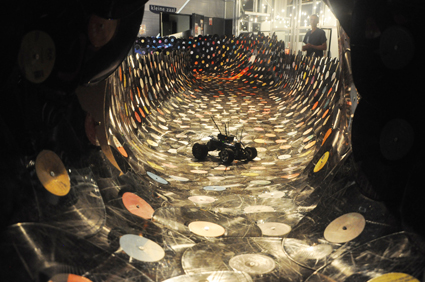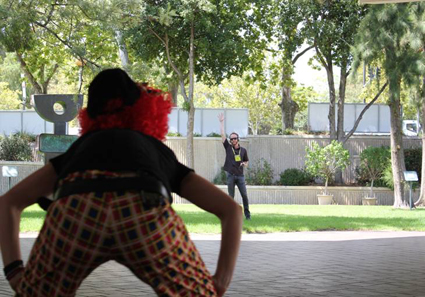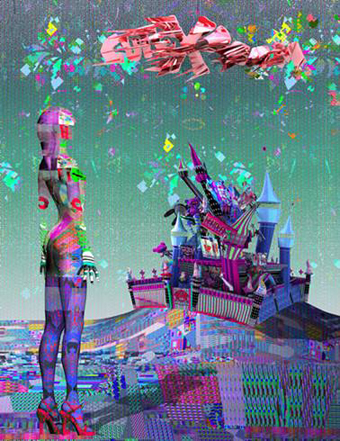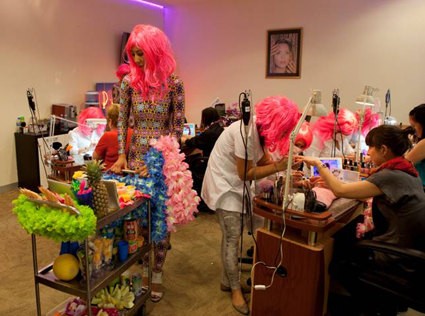art & games, a killer combination
ricardo peach: forum talk, game masters, acmi

Lucas Abela, Vinyl Rally Arcade
photo courtesy the artist
Lucas Abela, Vinyl Rally Arcade
ART AND GAMES MAKE A KILLER COMBINATION. SOME OF THE MOST EXCITING EXPERIMENTAL ARTWORKS CREATED IN AUSTRALIA IN RECENT YEARS ARE DEEPLY EMBEDDED IN GAMING CULTURE. GIVEN THAT THE NEW GENERATION OF ART LOVERS GREW UP WITH GAMES AS A SIGNIFICANT COMPONENT OF THEIR LIVES, IT’S NO WONDER THERE IS SUCH A STRONG DESIRE AND SUPPORT FOR INTERACTIVE, PARTICIPATORY CULTURE.
When I was asked to present at a forum for the Game Masters exhibition at the Australian Centre for the Moving Image (ACMI) in June 2012 on art and game culture, the main questions I had to ask myself were around definitions. What do we mean when we talk about art and games? And what does the actual work that the Australia Council supports in this area (either directly or indirectly through organisations) look like?
That blurry line between conceptually driven art and game culture was also prominent in my mind, as was the language required to describe the work developing in Australia.
As I collected images and examples of recently funded projects, I started creating loose categories. These bleed into each other by necessity and are of course open for review. But they allow me to create a conversation around what I have termed Art and Games in which I suggest five sub-categories: Game Art; Art Videogames; Game-Like Art; Game Culture Interventions; and Game Culture Initiatives.
game art

PVI Collective, Deviator, 2012
Game art is art that integrates gaming rules, structured play and reward/fail systems into the artwork. Works such as You Are Here’s Pemulwuy Dream Team (2009) and PVI Collective’s Deviator (2011) are two examples that illustrate how art can integrate game structures into the core aspect of the work.
In Pemulwuy Dream Team, artists Zanny Begg and Keg de Souza worked with the Redfern Indigenous and non-Indigenous communities to develop a Wii-remote boxing game filmed in the local Tony Mundine Gym. With the help of software developer Andy Nicholson, the artists developed a game around the story of Pemulwuy, a member of the Bidjigal clan of the Eora people who led Indigenous resistance to the European invasion when the First Fleet arrived in 1788. To win the game you had to beat not only the drug dealers but also the developers. No easy task.
PVI Collective’s locative media project Deviator (2011) is also a game-based work, structured to encourage players to intervene in public spaces with rewards and achievements unlocked as the game progresses. Activities on offer range from pole dancing in public to running away from a scary, kissing clown. And all the while participants are running against the clock to get points to increase their position on the scoreboard.
In both these works there are strong interventionist tactics at play that engage and critique the dominant political, social and economic orders of the spaces in which they are presented. At the core of this type of game art there is still a strong sense of critical engagement and questioning of the social status quo.
art videogames

Anita Fontaine, CuteXDoom II, 2008
Art videogames are electronic games that have been transformed into artworks or designed from scratch as pieces of contemporary art. These require artists to utilise game engine technologies to create the works.
Anita Fontaine’s CuteXdoom II (2008) is an example of an art videogame that explores the concept of hyper-consumerism through artistic interventions, with particular reference to Japanese otaku (obsession) and kawai (cuteness) subcultures.
On joining a consumerist ‘cult’ controlled by cute consumer objects, the first person player suddenly finds the cute objects turning violently aggressive, with the game spent trying to escape these creatures and return to non-consumerist calm. CuteXdoom II, the second installment of Fontaine’s work was exhibitied at Maxalot in partnership with Mike Pelletier (Champagne Valentine), where she used game engine technology from titles such as Unreal Tournament 3 to create artistic work in new game environments.
game-like art

Thea Baumann, Hologram Holiday part of Metaverse Makeover
photo Russell Shakespeare
Thea Baumann, Hologram Holiday part of Metaverse Makeover
Game-like arts uses gaming technology and virtual and augmented reality applications to create emerging forms of art through a range of new, often interactive work. Thea Baumann’s Hologram Holiday (2011) and Jimmy McGilchrist’s Curious Creatures (2011) are two examples of works that use playful, interactive, participatory, virtual and augmented reality work in a game-like capacity.
Hologram Holiday, part of a larger Live Art project managed by Baumann, titled Metaverse Makeover, involves a performative nail salon treatment, an experimental sound track, several ‘hologram hostesses’ assisting with new augmented reality nails and virtual reality applications. Nail technicians place special QR codes on clients’ fingernails, which when viewed through an application on a smart phone or mobile device, reveal three dimensional, virtual reality jewellery popping out of each nail. A cornucopia of virtual bling.
In McGilchrist’s Curious Creatures, game engine technology is used to generate 3D creatures projected onto fences. Each creature makes its own activity decisions based on the interaction of participants, created though ‘shadows’ generated with X-box Kinect technology tracking movements in front of each fence. An immersive, interactive jungle landscape is created with responsive AI inhabitants playing with punters.
Game-like art uses the tools of game engine and virtual reality technologies to invent new applications for both experimental arts practices and innovative community engagement.
game culture interventions
One of the more interesting recent developments is the evolution of artwork that critiques the cultural and social set-up of game culture itself. This is not a negative development—in fact it is a great sign that game culture plays a significant role in current cultural debate.
Work such as Computer Boy, a mixed reality performance by Blood Policy and Aphids, uses machinema and theatre to talk about issues of potential isolation for hyper-networked young people. The work also examines racial and gender stereotypes that are perpetuated in some of the games on the market at the moment. These works are not anti-gaming; they elevate game experiences to the same level as other cultural experiences and hold them accountable at that same level.
game culture initiatives
As well as funding the creation of art games, art video games, game-like art and game interventions, the Australia Council supports sector development initiatives that expand the capacity of artists working in virtual reality and game cultures. Two such initiatives include the Australian Centre for Virtual Art Laboratory (ACVA Lab) and the Interactive Media Innovation [imi] Project.
ACVA Lab, held in 2009, was a national gathering in Melbourne that explored the work of Australian artists and technologists using virtual and augmented reality platforms. As well as facilitating artistic networks and prototyping, ACVA curated and promoted Australian artists at the International Symposium of Electronic Art (ISEA) 2011 in Istanbul through Terra Virtualis, a nationally representative exhibition of new, virtual and augmented reality art. ACVA also supported Aroha Groves’ virtual world work Connections2, which was Highly Commended at the 2010 Telstra National Aboriginal and Torres Strait Islander Art Award.
The [imi] Project, supported through the Australia Council, the Australian Research Council, the Australian Film Television and Radio School (AFTRS) and the Queensland University of Technology, similarly champions national innovation in interactive design. It will place Australian artists in a number of Australia’s leading interactive media development companies, including Defiant Development, Halfbrick Studios (think Fruit Ninja), Hoodlum, Kennedy Miller Mitchell, League of Geeks, Mod Productions, the Project Factory and Tantalus Media.
60Sox’s Justin Brow and AFTRS’ Karen Pearlman will be liaising with the Australia Council to identify and place artists working with a range of artforms in these companies to cross-fertilise ideas and develop new concepts for emerging art and game projects.
the future
The Australia Council continues to support emerging and experimental practices for art and games through its general grant rounds and through special initiatives.
A major event coming up, where many of the works we have supported will be on display, is the ISEA 2013 in Sydney. This event will not only showcase key Australian and international electronic artworks of excellence, but also engage with innovative game culture art and its evolution as part of the program. I look forward to seeing the new work in development for ISEA 2013 and also being part of ongoing conversations on the role of art and games in Australia.
ACMI, Game Masters, Exhibition, Melbourne, June 28-Oct 28; forum, June 28
For enquires about the Interactive Media Innovation [imi] project go to www.imi-innovation.org
RealTime issue #111 Oct-Nov 2012 pg. 27






